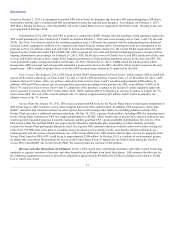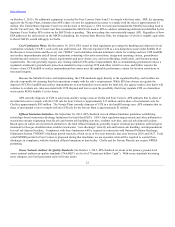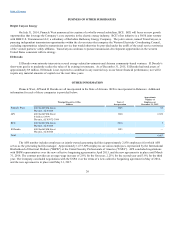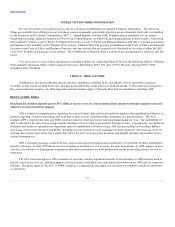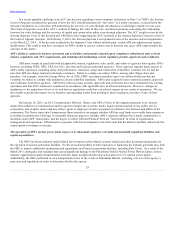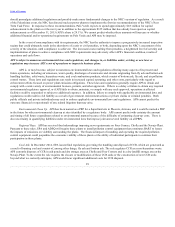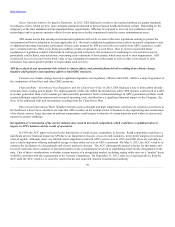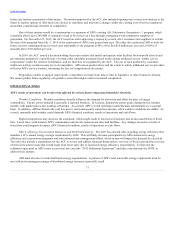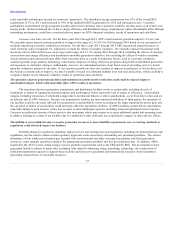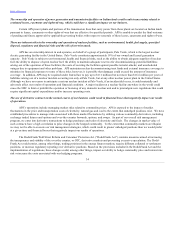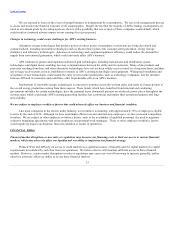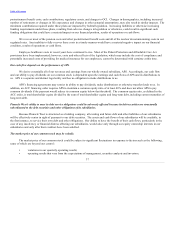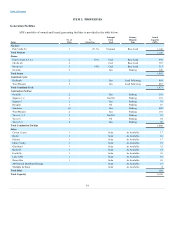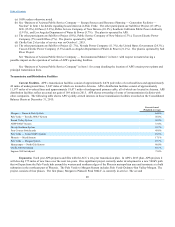APS 2015 Annual Report Download - page 34
Download and view the complete annual report
Please find page 34 of the 2015 APS annual report below. You can navigate through the pages in the report by either clicking on the pages listed below, or by using the keyword search tool below to find specific information within the annual report.
Table of Contents
before any further examination of this matter. The motion approved by the ACC also included opening one or more new dockets in the
future to explore options to offer more rate choices to customers and innovative changes within the existing cost-of-service regulatory
model that could include elements of competition.
One of these options would be a continuation or expansion of APS’s existing AG (Alternative Generation) - 1 program, which
essentially allows up to 200 MW of cumulative load to be served via a buy-through arrangement with competitive suppliers of
generation. On November 25, 2015, the ACC issued an order approving a request by several AG-1 customers and suppliers to extend
the term of the program from July 1, 2016 to the conclusion of APS's next general rate case. The order also authorized APS to defer for
future recovery unmitigated unrecovered costs attributable to the program at 90% of the first $10 million per year and at 100% of
amounts above $10 million per year.
In 2010, the ACC issued a decision holding that solar vendors that install and operate solar facilities for non-profit schools and
governments pursuant to a specific type of contract that calculates payments based on the energy produced are not “public service
corporations” under the Arizona Constitution, and are therefore not regulated by the ACC. The use of such products by customers
within our territory results in some level of competition. APS cannot predict when, and the extent to which, additional service providers
will enter APS’s service territory, increasing the level of competition in the market.
Proposals to enable or support retail electric competition are made from time to time in legislative or other forums in Arizona.
We cannot predict future regulatory or legislative action that might result in increased competition.
OPERATIONAL RISKS
APS’s results of operations can be adversely affected by various factors impacting demand for electricity.
Weather Conditions. Weather conditions directly influence the demand for electricity and affect the price of energy
commodities. Electric power demand is generally a seasonal business. In Arizona, demand for power peaks during the hot summer
months, with market prices also peaking at that time. As a result, APS’s overall operating results fluctuate substantially on a seasonal
basis. In addition, APS has historically sold less power, and consequently earned less income, when weather conditions are milder. As
a result, unusually mild weather could diminish APS’s financial condition, results of operations and cash flows.
Higher temperatures may decrease the snowpack, which might result in lowered soil moisture and an increased threat of forest
fires. Forest fires could threaten APS’s communities and electric transmission lines and facilities. Any damage caused as a result of
forest fires could negatively impact APS’s financial condition, results of operations or cash flows.
Effects of Energy Conservation Measures and Distributed Energy. The ACC has enacted rules regarding energy efficiency that
mandate a 22% annual energy savings requirement by 2020. This will likely increase participation by APS customers in energy
efficiency and conservation programs and other demand-side management efforts, which in turn will impact the demand for electricity.
The rules also include a requirement for the ACC to review and address financial disincentives, recovery of fixed costs and the recovery
of net lost income/revenue that would result from lower sales due to increased energy efficiency requirements. To that end, the
settlement agreement in APS’s most recent retail rate case (the “2012 Settlement Agreement”) includes a mechanism, the LFCR, to
address these matters.
APS must also meet certain distributed energy requirements. A portion of APS’s total renewable energy requirement must be
met with an increasing percentage of distributed energy resources (generally, small
31


